Mental Health Nursing Case Study: Assessment and Intervention
VerifiedAdded on 2022/11/18
|10
|2372
|136
Case Study
AI Summary
This case study examines the mental health of Munny Kaew, focusing on his depressive symptoms and the contributing factors to his condition. The assessment utilizes the mini-mental state exam and DSM-V criteria to diagnose major depressive disorder. The study explores the impact of traumatic childhood experiences and professional uncertainties on the patient's mental state, advocating for trauma-informed care and adherence to the NMBA code of conduct. The paper emphasizes the importance of respect, empowerment, and hope in the recovery process, highlighting the roles of nurses, family, and the community in supporting the patient's well-being. The case study provides a comprehensive analysis of the patient's condition, assessment, and potential interventions to promote his recovery and overall mental health.
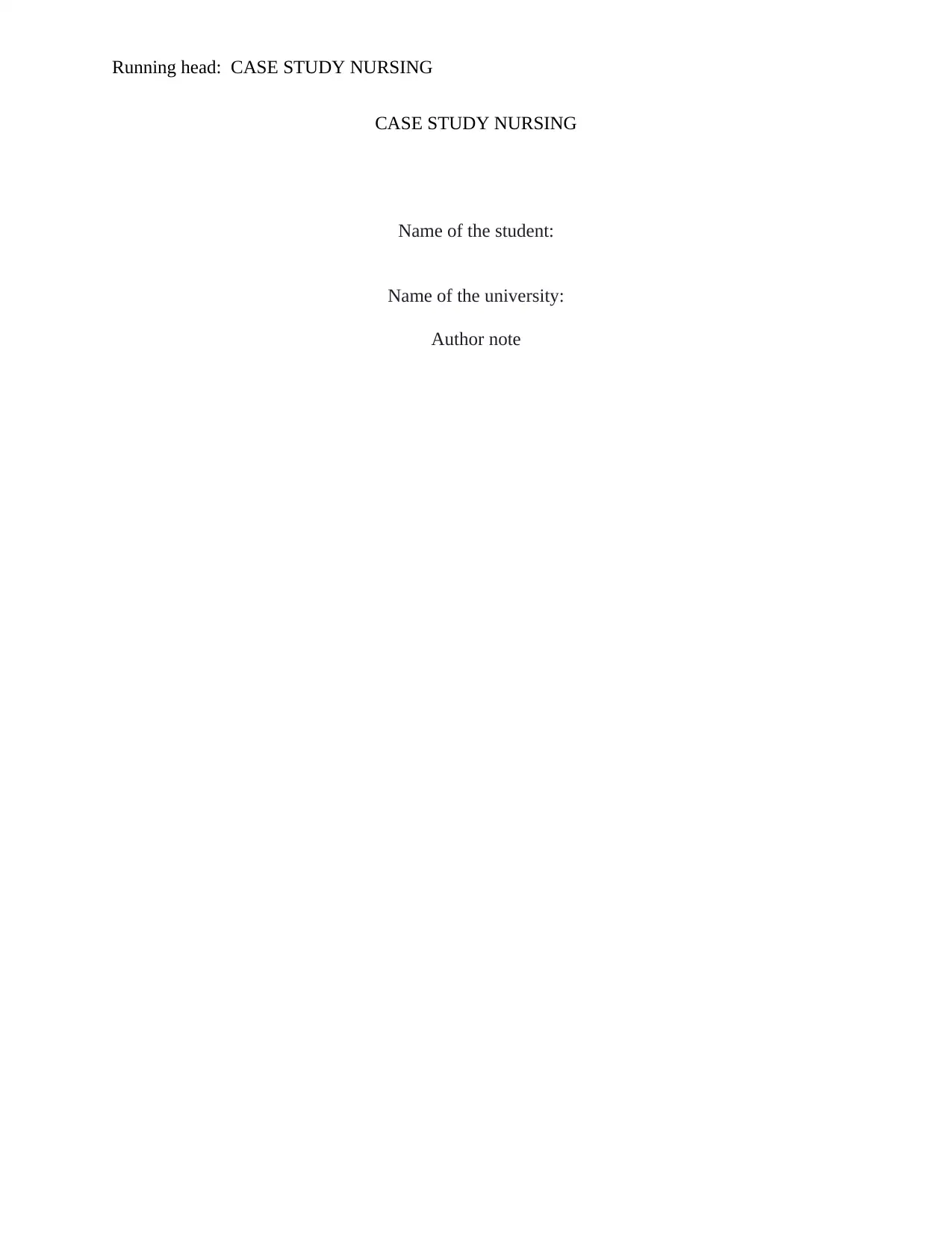
Running head: CASE STUDY NURSING
CASE STUDY NURSING
Name of the student:
Name of the university:
Author note
CASE STUDY NURSING
Name of the student:
Name of the university:
Author note
Paraphrase This Document
Need a fresh take? Get an instant paraphrase of this document with our AI Paraphraser
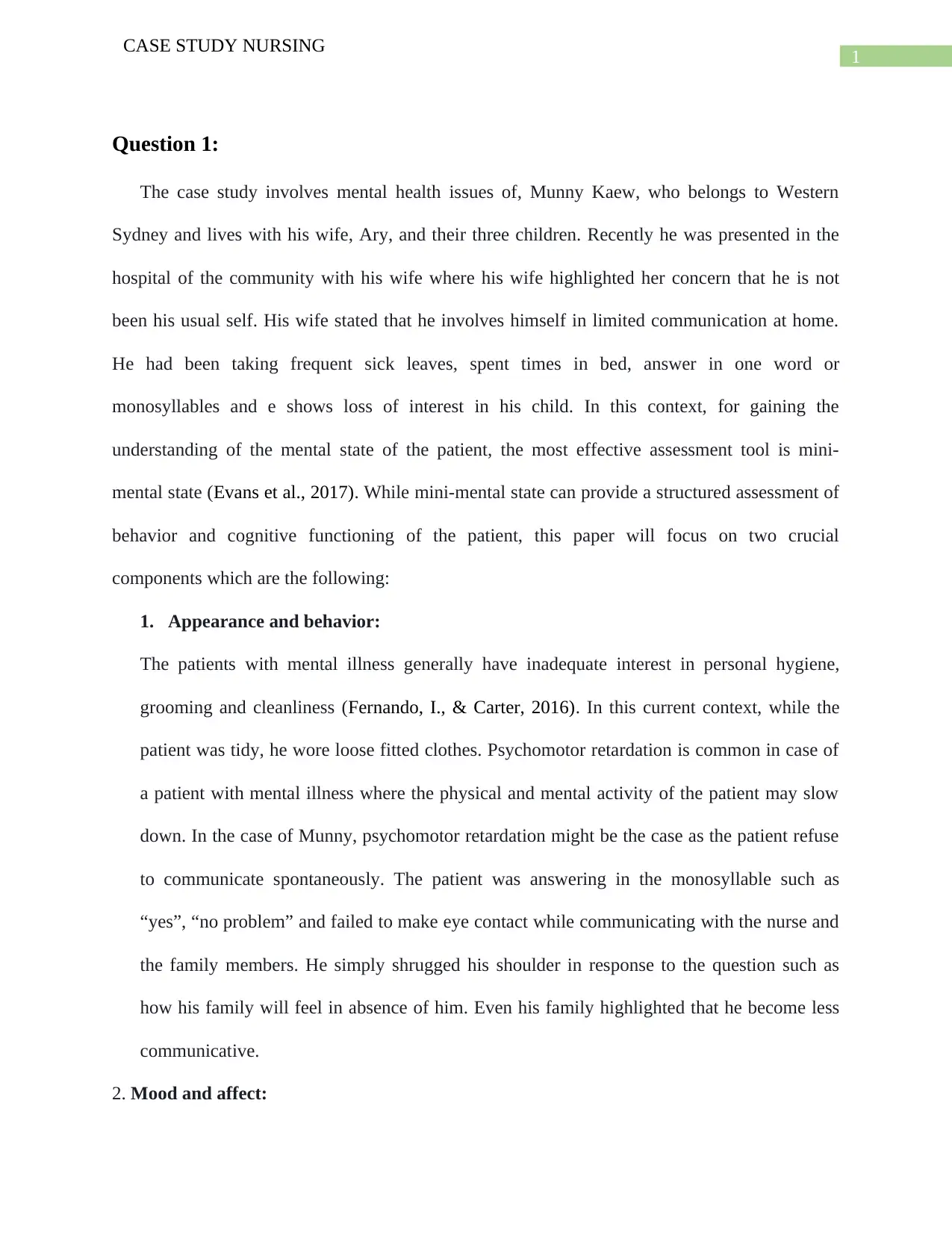
1
CASE STUDY NURSING
Question 1:
The case study involves mental health issues of, Munny Kaew, who belongs to Western
Sydney and lives with his wife, Ary, and their three children. Recently he was presented in the
hospital of the community with his wife where his wife highlighted her concern that he is not
been his usual self. His wife stated that he involves himself in limited communication at home.
He had been taking frequent sick leaves, spent times in bed, answer in one word or
monosyllables and e shows loss of interest in his child. In this context, for gaining the
understanding of the mental state of the patient, the most effective assessment tool is mini-
mental state (Evans et al., 2017). While mini-mental state can provide a structured assessment of
behavior and cognitive functioning of the patient, this paper will focus on two crucial
components which are the following:
1. Appearance and behavior:
The patients with mental illness generally have inadequate interest in personal hygiene,
grooming and cleanliness (Fernando, I., & Carter, 2016). In this current context, while the
patient was tidy, he wore loose fitted clothes. Psychomotor retardation is common in case of
a patient with mental illness where the physical and mental activity of the patient may slow
down. In the case of Munny, psychomotor retardation might be the case as the patient refuse
to communicate spontaneously. The patient was answering in the monosyllable such as
“yes”, “no problem” and failed to make eye contact while communicating with the nurse and
the family members. He simply shrugged his shoulder in response to the question such as
how his family will feel in absence of him. Even his family highlighted that he become less
communicative.
2. Mood and affect:
CASE STUDY NURSING
Question 1:
The case study involves mental health issues of, Munny Kaew, who belongs to Western
Sydney and lives with his wife, Ary, and their three children. Recently he was presented in the
hospital of the community with his wife where his wife highlighted her concern that he is not
been his usual self. His wife stated that he involves himself in limited communication at home.
He had been taking frequent sick leaves, spent times in bed, answer in one word or
monosyllables and e shows loss of interest in his child. In this context, for gaining the
understanding of the mental state of the patient, the most effective assessment tool is mini-
mental state (Evans et al., 2017). While mini-mental state can provide a structured assessment of
behavior and cognitive functioning of the patient, this paper will focus on two crucial
components which are the following:
1. Appearance and behavior:
The patients with mental illness generally have inadequate interest in personal hygiene,
grooming and cleanliness (Fernando, I., & Carter, 2016). In this current context, while the
patient was tidy, he wore loose fitted clothes. Psychomotor retardation is common in case of
a patient with mental illness where the physical and mental activity of the patient may slow
down. In the case of Munny, psychomotor retardation might be the case as the patient refuse
to communicate spontaneously. The patient was answering in the monosyllable such as
“yes”, “no problem” and failed to make eye contact while communicating with the nurse and
the family members. He simply shrugged his shoulder in response to the question such as
how his family will feel in absence of him. Even his family highlighted that he become less
communicative.
2. Mood and affect:
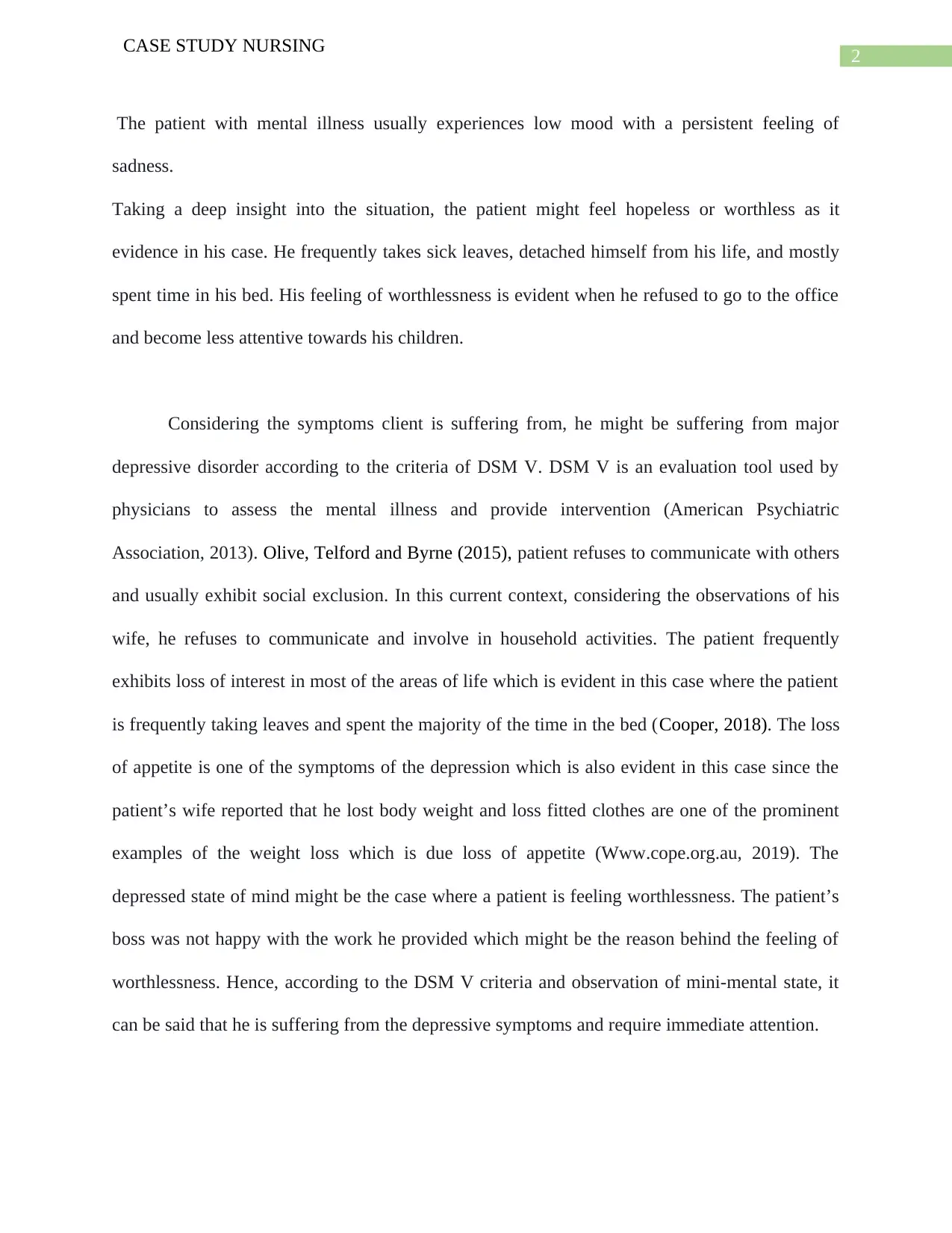
2
CASE STUDY NURSING
The patient with mental illness usually experiences low mood with a persistent feeling of
sadness.
Taking a deep insight into the situation, the patient might feel hopeless or worthless as it
evidence in his case. He frequently takes sick leaves, detached himself from his life, and mostly
spent time in his bed. His feeling of worthlessness is evident when he refused to go to the office
and become less attentive towards his children.
Considering the symptoms client is suffering from, he might be suffering from major
depressive disorder according to the criteria of DSM V. DSM V is an evaluation tool used by
physicians to assess the mental illness and provide intervention (American Psychiatric
Association, 2013). Olive, Telford and Byrne (2015), patient refuses to communicate with others
and usually exhibit social exclusion. In this current context, considering the observations of his
wife, he refuses to communicate and involve in household activities. The patient frequently
exhibits loss of interest in most of the areas of life which is evident in this case where the patient
is frequently taking leaves and spent the majority of the time in the bed (Cooper, 2018). The loss
of appetite is one of the symptoms of the depression which is also evident in this case since the
patient’s wife reported that he lost body weight and loss fitted clothes are one of the prominent
examples of the weight loss which is due loss of appetite (Www.cope.org.au, 2019). The
depressed state of mind might be the case where a patient is feeling worthlessness. The patient’s
boss was not happy with the work he provided which might be the reason behind the feeling of
worthlessness. Hence, according to the DSM V criteria and observation of mini-mental state, it
can be said that he is suffering from the depressive symptoms and require immediate attention.
CASE STUDY NURSING
The patient with mental illness usually experiences low mood with a persistent feeling of
sadness.
Taking a deep insight into the situation, the patient might feel hopeless or worthless as it
evidence in his case. He frequently takes sick leaves, detached himself from his life, and mostly
spent time in his bed. His feeling of worthlessness is evident when he refused to go to the office
and become less attentive towards his children.
Considering the symptoms client is suffering from, he might be suffering from major
depressive disorder according to the criteria of DSM V. DSM V is an evaluation tool used by
physicians to assess the mental illness and provide intervention (American Psychiatric
Association, 2013). Olive, Telford and Byrne (2015), patient refuses to communicate with others
and usually exhibit social exclusion. In this current context, considering the observations of his
wife, he refuses to communicate and involve in household activities. The patient frequently
exhibits loss of interest in most of the areas of life which is evident in this case where the patient
is frequently taking leaves and spent the majority of the time in the bed (Cooper, 2018). The loss
of appetite is one of the symptoms of the depression which is also evident in this case since the
patient’s wife reported that he lost body weight and loss fitted clothes are one of the prominent
examples of the weight loss which is due loss of appetite (Www.cope.org.au, 2019). The
depressed state of mind might be the case where a patient is feeling worthlessness. The patient’s
boss was not happy with the work he provided which might be the reason behind the feeling of
worthlessness. Hence, according to the DSM V criteria and observation of mini-mental state, it
can be said that he is suffering from the depressive symptoms and require immediate attention.
⊘ This is a preview!⊘
Do you want full access?
Subscribe today to unlock all pages.

Trusted by 1+ million students worldwide
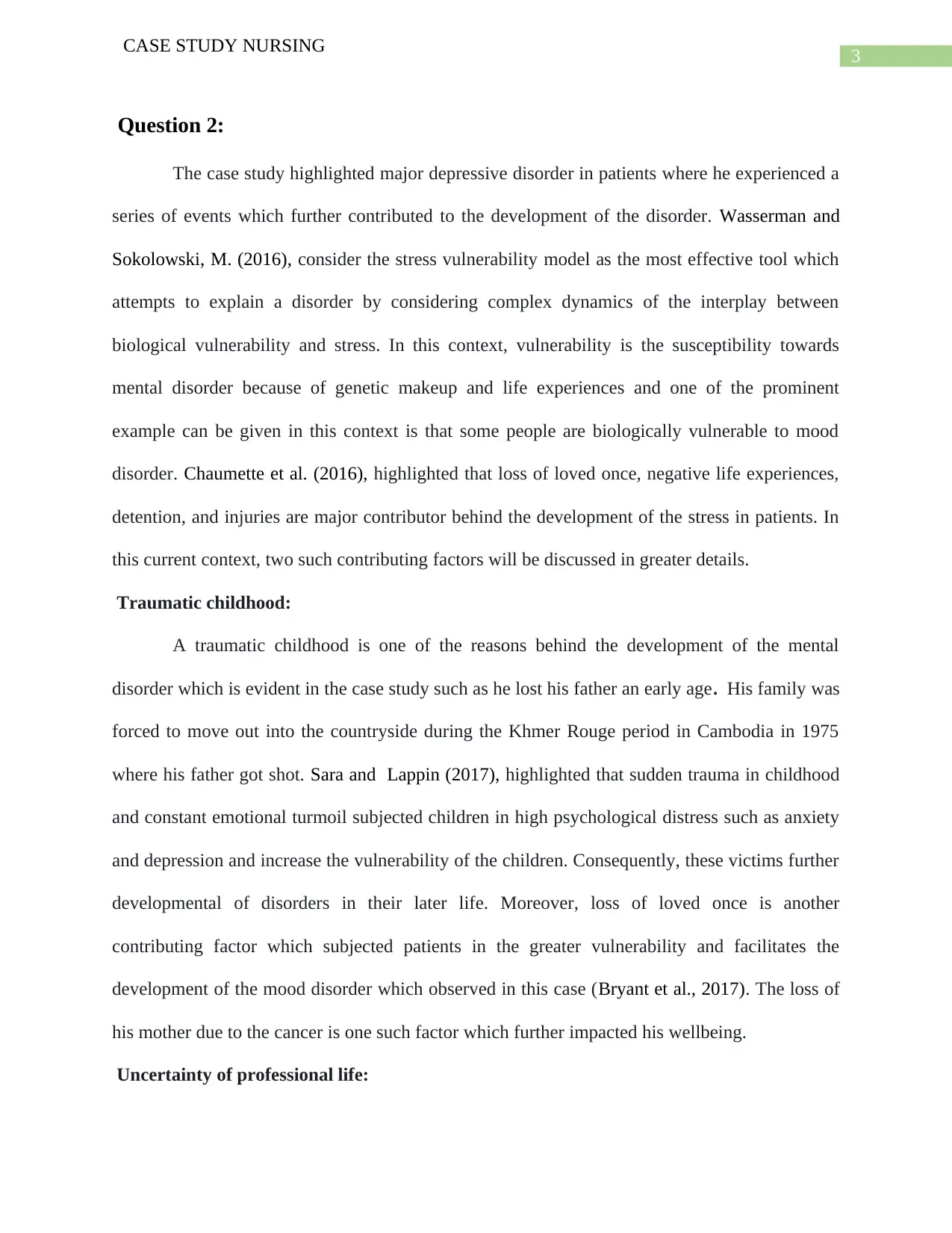
3
CASE STUDY NURSING
Question 2:
The case study highlighted major depressive disorder in patients where he experienced a
series of events which further contributed to the development of the disorder. Wasserman and
Sokolowski, M. (2016), consider the stress vulnerability model as the most effective tool which
attempts to explain a disorder by considering complex dynamics of the interplay between
biological vulnerability and stress. In this context, vulnerability is the susceptibility towards
mental disorder because of genetic makeup and life experiences and one of the prominent
example can be given in this context is that some people are biologically vulnerable to mood
disorder. Chaumette et al. (2016), highlighted that loss of loved once, negative life experiences,
detention, and injuries are major contributor behind the development of the stress in patients. In
this current context, two such contributing factors will be discussed in greater details.
Traumatic childhood:
A traumatic childhood is one of the reasons behind the development of the mental
disorder which is evident in the case study such as he lost his father an early age. His family was
forced to move out into the countryside during the Khmer Rouge period in Cambodia in 1975
where his father got shot. Sara and Lappin (2017), highlighted that sudden trauma in childhood
and constant emotional turmoil subjected children in high psychological distress such as anxiety
and depression and increase the vulnerability of the children. Consequently, these victims further
developmental of disorders in their later life. Moreover, loss of loved once is another
contributing factor which subjected patients in the greater vulnerability and facilitates the
development of the mood disorder which observed in this case (Bryant et al., 2017). The loss of
his mother due to the cancer is one such factor which further impacted his wellbeing.
Uncertainty of professional life:
CASE STUDY NURSING
Question 2:
The case study highlighted major depressive disorder in patients where he experienced a
series of events which further contributed to the development of the disorder. Wasserman and
Sokolowski, M. (2016), consider the stress vulnerability model as the most effective tool which
attempts to explain a disorder by considering complex dynamics of the interplay between
biological vulnerability and stress. In this context, vulnerability is the susceptibility towards
mental disorder because of genetic makeup and life experiences and one of the prominent
example can be given in this context is that some people are biologically vulnerable to mood
disorder. Chaumette et al. (2016), highlighted that loss of loved once, negative life experiences,
detention, and injuries are major contributor behind the development of the stress in patients. In
this current context, two such contributing factors will be discussed in greater details.
Traumatic childhood:
A traumatic childhood is one of the reasons behind the development of the mental
disorder which is evident in the case study such as he lost his father an early age. His family was
forced to move out into the countryside during the Khmer Rouge period in Cambodia in 1975
where his father got shot. Sara and Lappin (2017), highlighted that sudden trauma in childhood
and constant emotional turmoil subjected children in high psychological distress such as anxiety
and depression and increase the vulnerability of the children. Consequently, these victims further
developmental of disorders in their later life. Moreover, loss of loved once is another
contributing factor which subjected patients in the greater vulnerability and facilitates the
development of the mood disorder which observed in this case (Bryant et al., 2017). The loss of
his mother due to the cancer is one such factor which further impacted his wellbeing.
Uncertainty of professional life:
Paraphrase This Document
Need a fresh take? Get an instant paraphrase of this document with our AI Paraphraser
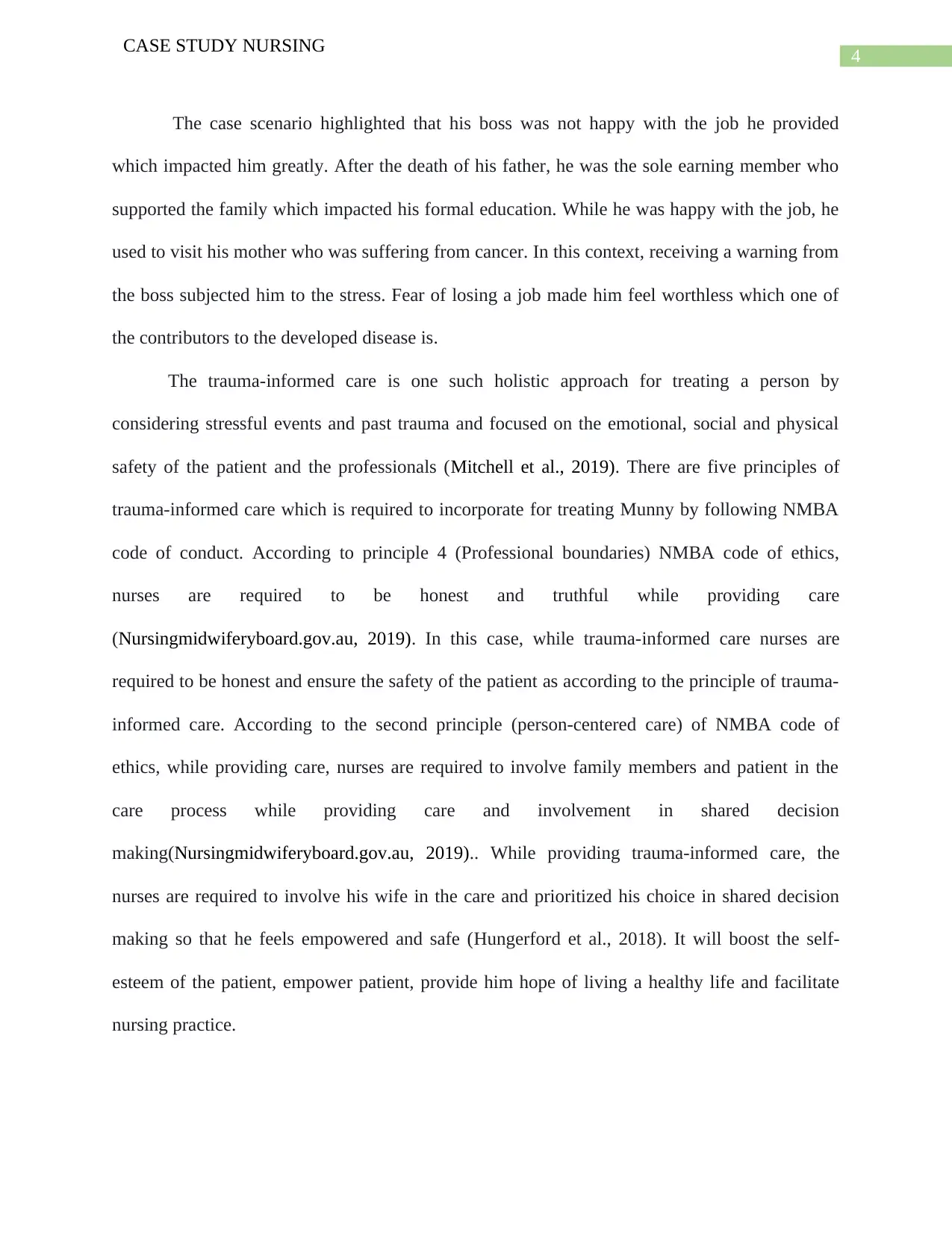
4
CASE STUDY NURSING
The case scenario highlighted that his boss was not happy with the job he provided
which impacted him greatly. After the death of his father, he was the sole earning member who
supported the family which impacted his formal education. While he was happy with the job, he
used to visit his mother who was suffering from cancer. In this context, receiving a warning from
the boss subjected him to the stress. Fear of losing a job made him feel worthless which one of
the contributors to the developed disease is.
The trauma-informed care is one such holistic approach for treating a person by
considering stressful events and past trauma and focused on the emotional, social and physical
safety of the patient and the professionals (Mitchell et al., 2019). There are five principles of
trauma-informed care which is required to incorporate for treating Munny by following NMBA
code of conduct. According to principle 4 (Professional boundaries) NMBA code of ethics,
nurses are required to be honest and truthful while providing care
(Nursingmidwiferyboard.gov.au, 2019). In this case, while trauma-informed care nurses are
required to be honest and ensure the safety of the patient as according to the principle of trauma-
informed care. According to the second principle (person-centered care) of NMBA code of
ethics, while providing care, nurses are required to involve family members and patient in the
care process while providing care and involvement in shared decision
making(Nursingmidwiferyboard.gov.au, 2019).. While providing trauma-informed care, the
nurses are required to involve his wife in the care and prioritized his choice in shared decision
making so that he feels empowered and safe (Hungerford et al., 2018). It will boost the self-
esteem of the patient, empower patient, provide him hope of living a healthy life and facilitate
nursing practice.
CASE STUDY NURSING
The case scenario highlighted that his boss was not happy with the job he provided
which impacted him greatly. After the death of his father, he was the sole earning member who
supported the family which impacted his formal education. While he was happy with the job, he
used to visit his mother who was suffering from cancer. In this context, receiving a warning from
the boss subjected him to the stress. Fear of losing a job made him feel worthless which one of
the contributors to the developed disease is.
The trauma-informed care is one such holistic approach for treating a person by
considering stressful events and past trauma and focused on the emotional, social and physical
safety of the patient and the professionals (Mitchell et al., 2019). There are five principles of
trauma-informed care which is required to incorporate for treating Munny by following NMBA
code of conduct. According to principle 4 (Professional boundaries) NMBA code of ethics,
nurses are required to be honest and truthful while providing care
(Nursingmidwiferyboard.gov.au, 2019). In this case, while trauma-informed care nurses are
required to be honest and ensure the safety of the patient as according to the principle of trauma-
informed care. According to the second principle (person-centered care) of NMBA code of
ethics, while providing care, nurses are required to involve family members and patient in the
care process while providing care and involvement in shared decision
making(Nursingmidwiferyboard.gov.au, 2019).. While providing trauma-informed care, the
nurses are required to involve his wife in the care and prioritized his choice in shared decision
making so that he feels empowered and safe (Hungerford et al., 2018). It will boost the self-
esteem of the patient, empower patient, provide him hope of living a healthy life and facilitate
nursing practice.
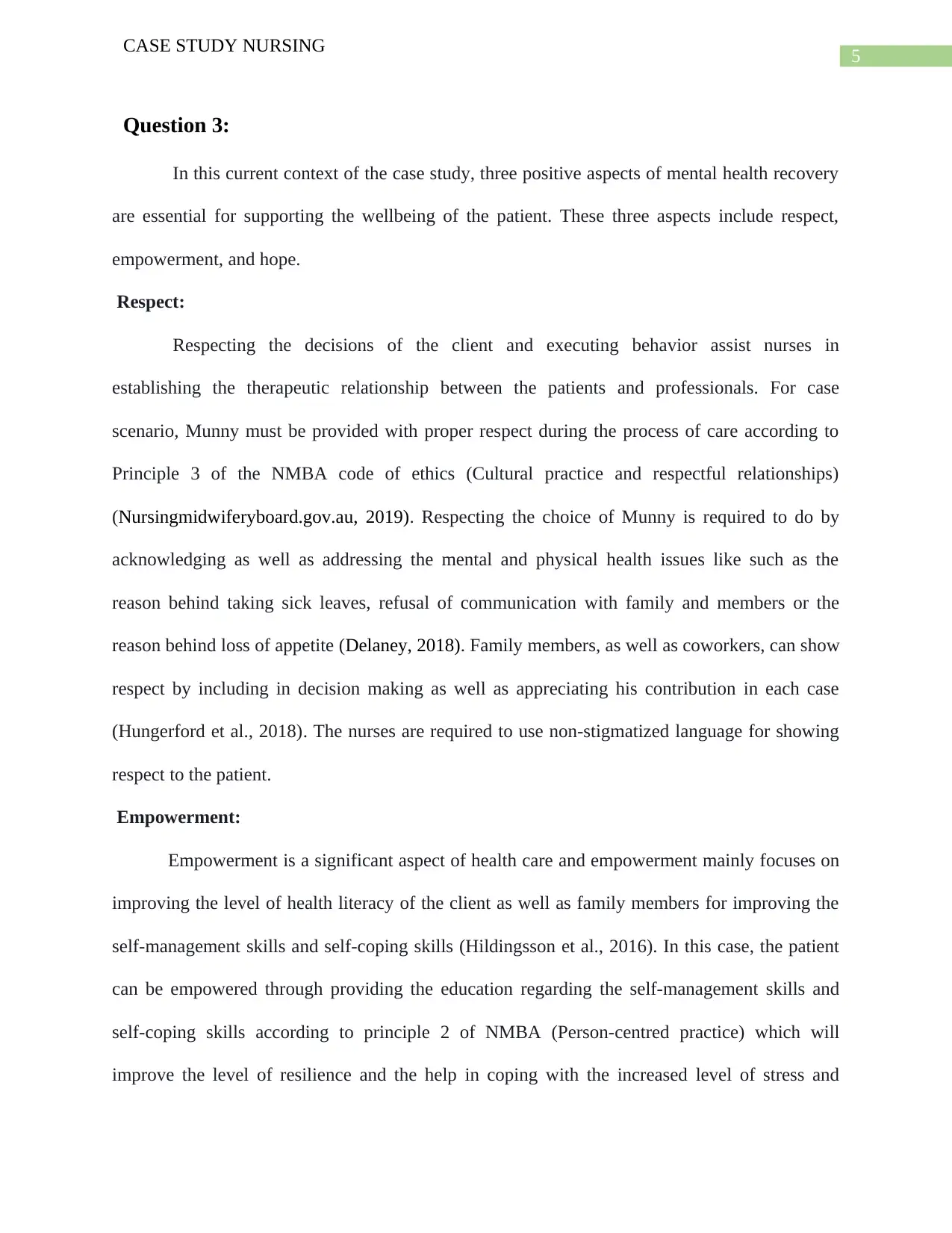
5
CASE STUDY NURSING
Question 3:
In this current context of the case study, three positive aspects of mental health recovery
are essential for supporting the wellbeing of the patient. These three aspects include respect,
empowerment, and hope.
Respect:
Respecting the decisions of the client and executing behavior assist nurses in
establishing the therapeutic relationship between the patients and professionals. For case
scenario, Munny must be provided with proper respect during the process of care according to
Principle 3 of the NMBA code of ethics (Cultural practice and respectful relationships)
(Nursingmidwiferyboard.gov.au, 2019). Respecting the choice of Munny is required to do by
acknowledging as well as addressing the mental and physical health issues like such as the
reason behind taking sick leaves, refusal of communication with family and members or the
reason behind loss of appetite (Delaney, 2018). Family members, as well as coworkers, can show
respect by including in decision making as well as appreciating his contribution in each case
(Hungerford et al., 2018). The nurses are required to use non-stigmatized language for showing
respect to the patient.
Empowerment:
Empowerment is a significant aspect of health care and empowerment mainly focuses on
improving the level of health literacy of the client as well as family members for improving the
self-management skills and self-coping skills (Hildingsson et al., 2016). In this case, the patient
can be empowered through providing the education regarding the self-management skills and
self-coping skills according to principle 2 of NMBA (Person-centred practice) which will
improve the level of resilience and the help in coping with the increased level of stress and
CASE STUDY NURSING
Question 3:
In this current context of the case study, three positive aspects of mental health recovery
are essential for supporting the wellbeing of the patient. These three aspects include respect,
empowerment, and hope.
Respect:
Respecting the decisions of the client and executing behavior assist nurses in
establishing the therapeutic relationship between the patients and professionals. For case
scenario, Munny must be provided with proper respect during the process of care according to
Principle 3 of the NMBA code of ethics (Cultural practice and respectful relationships)
(Nursingmidwiferyboard.gov.au, 2019). Respecting the choice of Munny is required to do by
acknowledging as well as addressing the mental and physical health issues like such as the
reason behind taking sick leaves, refusal of communication with family and members or the
reason behind loss of appetite (Delaney, 2018). Family members, as well as coworkers, can show
respect by including in decision making as well as appreciating his contribution in each case
(Hungerford et al., 2018). The nurses are required to use non-stigmatized language for showing
respect to the patient.
Empowerment:
Empowerment is a significant aspect of health care and empowerment mainly focuses on
improving the level of health literacy of the client as well as family members for improving the
self-management skills and self-coping skills (Hildingsson et al., 2016). In this case, the patient
can be empowered through providing the education regarding the self-management skills and
self-coping skills according to principle 2 of NMBA (Person-centred practice) which will
improve the level of resilience and the help in coping with the increased level of stress and
⊘ This is a preview!⊘
Do you want full access?
Subscribe today to unlock all pages.

Trusted by 1+ million students worldwide
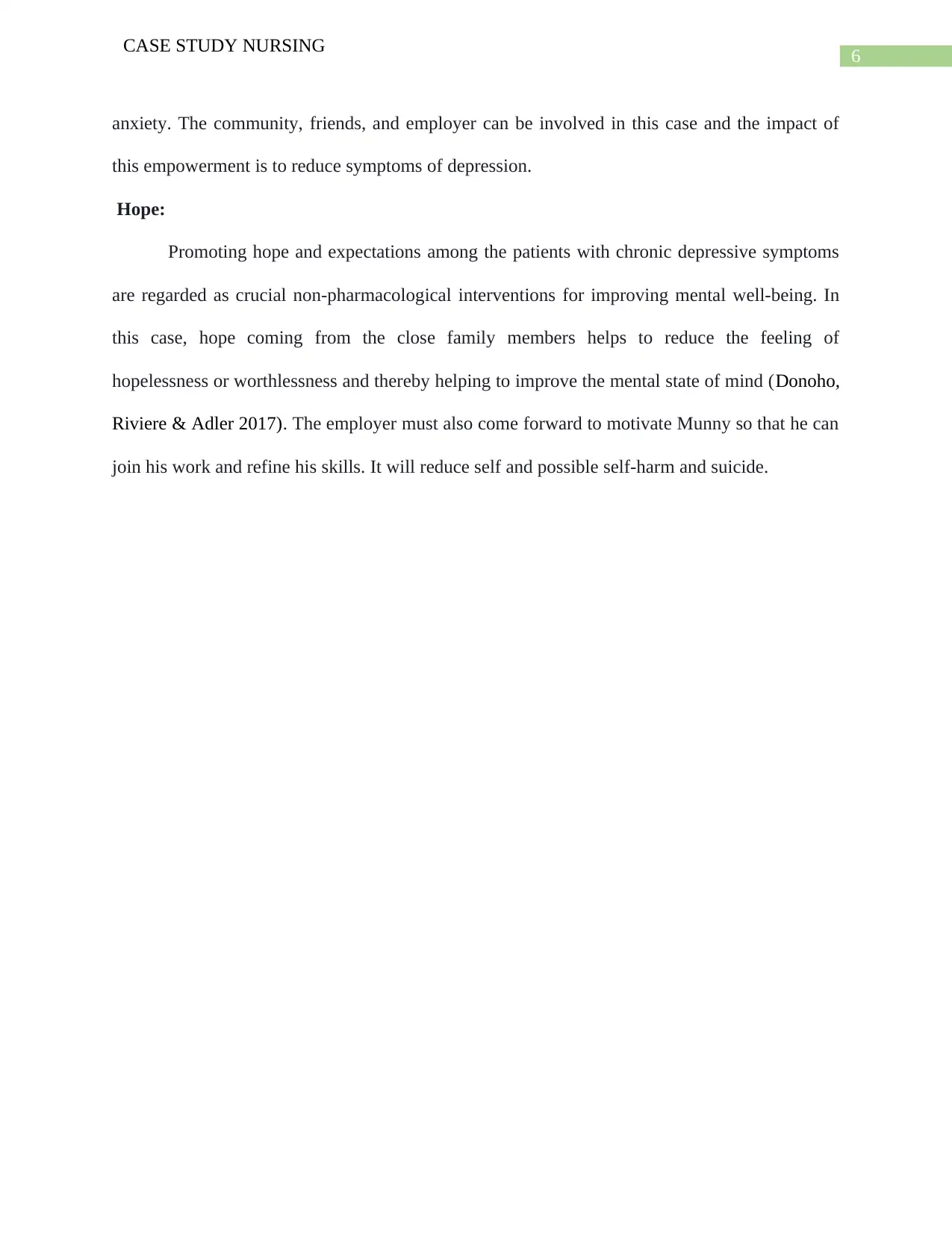
6
CASE STUDY NURSING
anxiety. The community, friends, and employer can be involved in this case and the impact of
this empowerment is to reduce symptoms of depression.
Hope:
Promoting hope and expectations among the patients with chronic depressive symptoms
are regarded as crucial non-pharmacological interventions for improving mental well-being. In
this case, hope coming from the close family members helps to reduce the feeling of
hopelessness or worthlessness and thereby helping to improve the mental state of mind (Donoho,
Riviere & Adler 2017). The employer must also come forward to motivate Munny so that he can
join his work and refine his skills. It will reduce self and possible self-harm and suicide.
CASE STUDY NURSING
anxiety. The community, friends, and employer can be involved in this case and the impact of
this empowerment is to reduce symptoms of depression.
Hope:
Promoting hope and expectations among the patients with chronic depressive symptoms
are regarded as crucial non-pharmacological interventions for improving mental well-being. In
this case, hope coming from the close family members helps to reduce the feeling of
hopelessness or worthlessness and thereby helping to improve the mental state of mind (Donoho,
Riviere & Adler 2017). The employer must also come forward to motivate Munny so that he can
join his work and refine his skills. It will reduce self and possible self-harm and suicide.
Paraphrase This Document
Need a fresh take? Get an instant paraphrase of this document with our AI Paraphraser
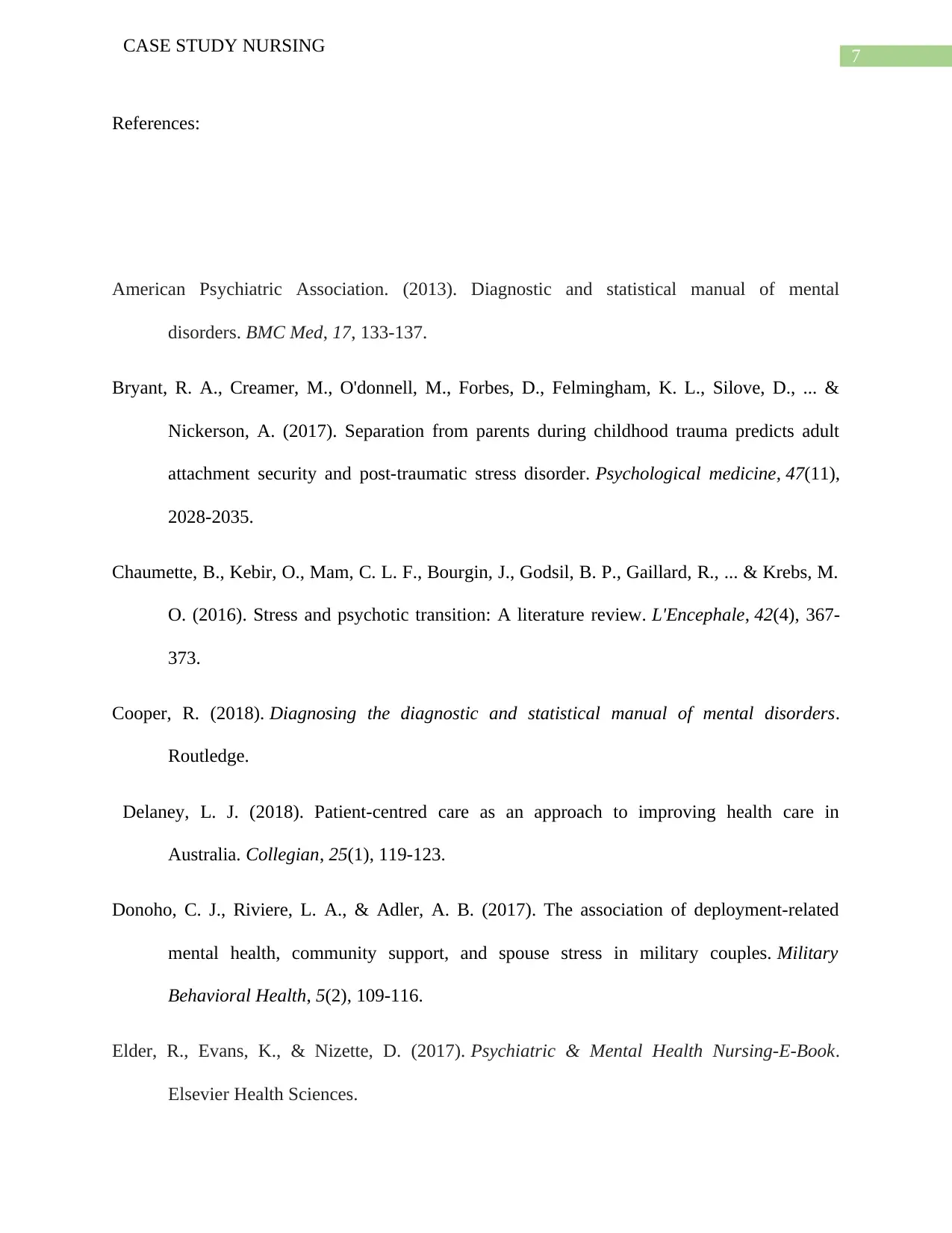
7
CASE STUDY NURSING
References:
American Psychiatric Association. (2013). Diagnostic and statistical manual of mental
disorders. BMC Med, 17, 133-137.
Bryant, R. A., Creamer, M., O'donnell, M., Forbes, D., Felmingham, K. L., Silove, D., ... &
Nickerson, A. (2017). Separation from parents during childhood trauma predicts adult
attachment security and post-traumatic stress disorder. Psychological medicine, 47(11),
2028-2035.
Chaumette, B., Kebir, O., Mam, C. L. F., Bourgin, J., Godsil, B. P., Gaillard, R., ... & Krebs, M.
O. (2016). Stress and psychotic transition: A literature review. L'Encephale, 42(4), 367-
373.
Cooper, R. (2018). Diagnosing the diagnostic and statistical manual of mental disorders.
Routledge.
Delaney, L. J. (2018). Patient-centred care as an approach to improving health care in
Australia. Collegian, 25(1), 119-123.
Donoho, C. J., Riviere, L. A., & Adler, A. B. (2017). The association of deployment-related
mental health, community support, and spouse stress in military couples. Military
Behavioral Health, 5(2), 109-116.
Elder, R., Evans, K., & Nizette, D. (2017). Psychiatric & Mental Health Nursing-E-Book.
Elsevier Health Sciences.
CASE STUDY NURSING
References:
American Psychiatric Association. (2013). Diagnostic and statistical manual of mental
disorders. BMC Med, 17, 133-137.
Bryant, R. A., Creamer, M., O'donnell, M., Forbes, D., Felmingham, K. L., Silove, D., ... &
Nickerson, A. (2017). Separation from parents during childhood trauma predicts adult
attachment security and post-traumatic stress disorder. Psychological medicine, 47(11),
2028-2035.
Chaumette, B., Kebir, O., Mam, C. L. F., Bourgin, J., Godsil, B. P., Gaillard, R., ... & Krebs, M.
O. (2016). Stress and psychotic transition: A literature review. L'Encephale, 42(4), 367-
373.
Cooper, R. (2018). Diagnosing the diagnostic and statistical manual of mental disorders.
Routledge.
Delaney, L. J. (2018). Patient-centred care as an approach to improving health care in
Australia. Collegian, 25(1), 119-123.
Donoho, C. J., Riviere, L. A., & Adler, A. B. (2017). The association of deployment-related
mental health, community support, and spouse stress in military couples. Military
Behavioral Health, 5(2), 109-116.
Elder, R., Evans, K., & Nizette, D. (2017). Psychiatric & Mental Health Nursing-E-Book.
Elsevier Health Sciences.
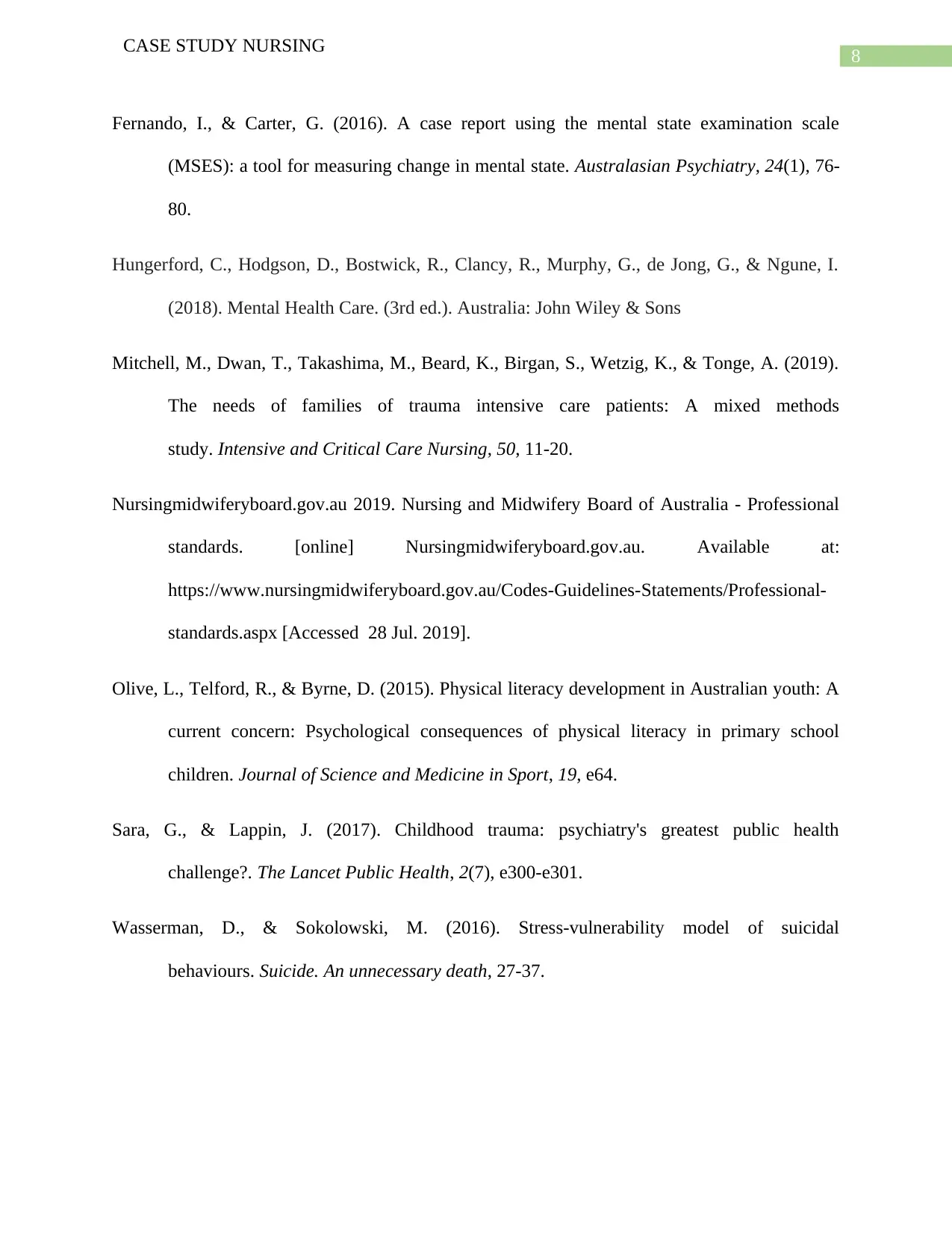
8
CASE STUDY NURSING
Fernando, I., & Carter, G. (2016). A case report using the mental state examination scale
(MSES): a tool for measuring change in mental state. Australasian Psychiatry, 24(1), 76-
80.
Hungerford, C., Hodgson, D., Bostwick, R., Clancy, R., Murphy, G., de Jong, G., & Ngune, I.
(2018). Mental Health Care. (3rd ed.). Australia: John Wiley & Sons
Mitchell, M., Dwan, T., Takashima, M., Beard, K., Birgan, S., Wetzig, K., & Tonge, A. (2019).
The needs of families of trauma intensive care patients: A mixed methods
study. Intensive and Critical Care Nursing, 50, 11-20.
Nursingmidwiferyboard.gov.au 2019. Nursing and Midwifery Board of Australia - Professional
standards. [online] Nursingmidwiferyboard.gov.au. Available at:
https://www.nursingmidwiferyboard.gov.au/Codes-Guidelines-Statements/Professional-
standards.aspx [Accessed 28 Jul. 2019].
Olive, L., Telford, R., & Byrne, D. (2015). Physical literacy development in Australian youth: A
current concern: Psychological consequences of physical literacy in primary school
children. Journal of Science and Medicine in Sport, 19, e64.
Sara, G., & Lappin, J. (2017). Childhood trauma: psychiatry's greatest public health
challenge?. The Lancet Public Health, 2(7), e300-e301.
Wasserman, D., & Sokolowski, M. (2016). Stress-vulnerability model of suicidal
behaviours. Suicide. An unnecessary death, 27-37.
CASE STUDY NURSING
Fernando, I., & Carter, G. (2016). A case report using the mental state examination scale
(MSES): a tool for measuring change in mental state. Australasian Psychiatry, 24(1), 76-
80.
Hungerford, C., Hodgson, D., Bostwick, R., Clancy, R., Murphy, G., de Jong, G., & Ngune, I.
(2018). Mental Health Care. (3rd ed.). Australia: John Wiley & Sons
Mitchell, M., Dwan, T., Takashima, M., Beard, K., Birgan, S., Wetzig, K., & Tonge, A. (2019).
The needs of families of trauma intensive care patients: A mixed methods
study. Intensive and Critical Care Nursing, 50, 11-20.
Nursingmidwiferyboard.gov.au 2019. Nursing and Midwifery Board of Australia - Professional
standards. [online] Nursingmidwiferyboard.gov.au. Available at:
https://www.nursingmidwiferyboard.gov.au/Codes-Guidelines-Statements/Professional-
standards.aspx [Accessed 28 Jul. 2019].
Olive, L., Telford, R., & Byrne, D. (2015). Physical literacy development in Australian youth: A
current concern: Psychological consequences of physical literacy in primary school
children. Journal of Science and Medicine in Sport, 19, e64.
Sara, G., & Lappin, J. (2017). Childhood trauma: psychiatry's greatest public health
challenge?. The Lancet Public Health, 2(7), e300-e301.
Wasserman, D., & Sokolowski, M. (2016). Stress-vulnerability model of suicidal
behaviours. Suicide. An unnecessary death, 27-37.
⊘ This is a preview!⊘
Do you want full access?
Subscribe today to unlock all pages.

Trusted by 1+ million students worldwide
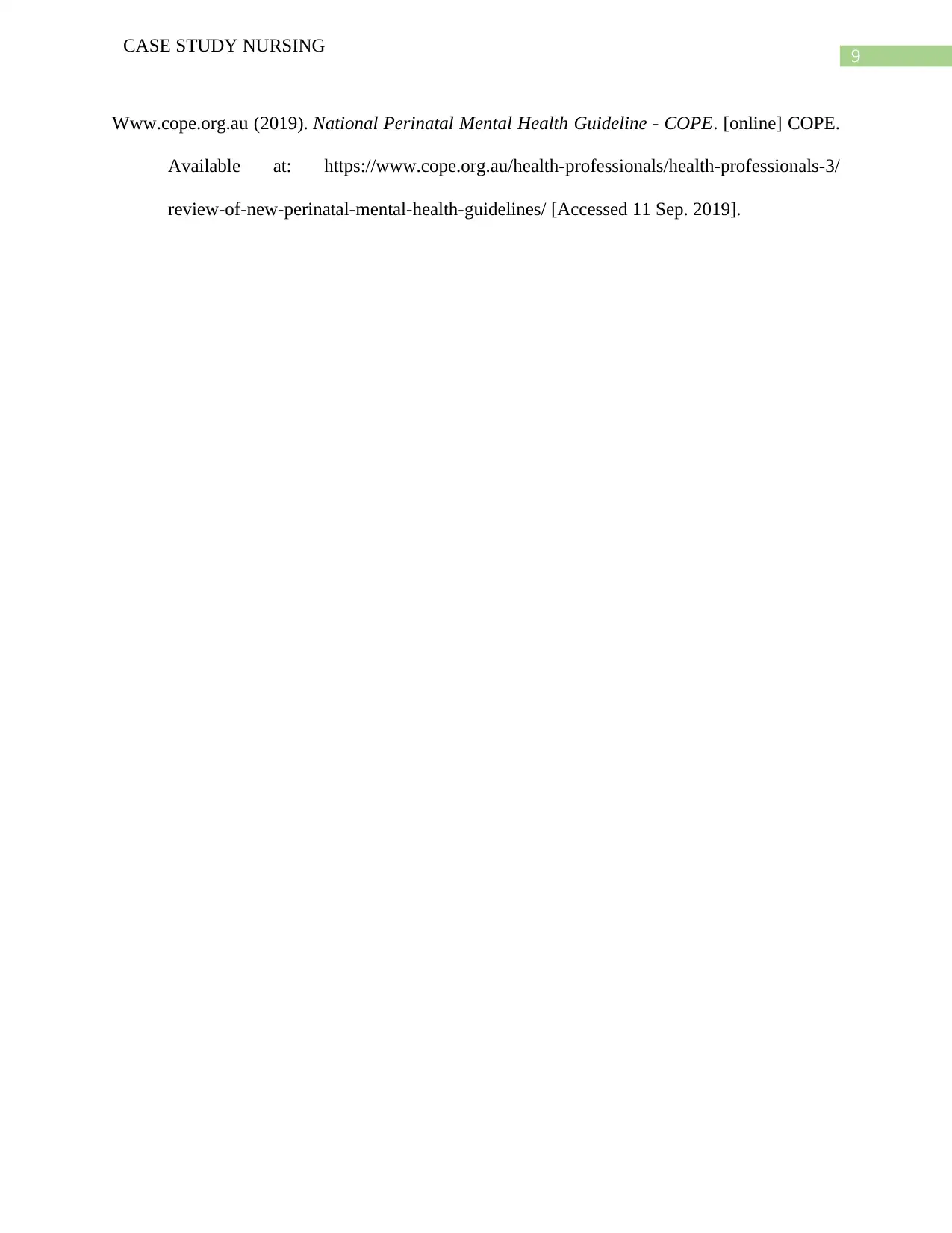
9
CASE STUDY NURSING
Www.cope.org.au (2019). National Perinatal Mental Health Guideline - COPE. [online] COPE.
Available at: https://www.cope.org.au/health-professionals/health-professionals-3/
review-of-new-perinatal-mental-health-guidelines/ [Accessed 11 Sep. 2019].
CASE STUDY NURSING
Www.cope.org.au (2019). National Perinatal Mental Health Guideline - COPE. [online] COPE.
Available at: https://www.cope.org.au/health-professionals/health-professionals-3/
review-of-new-perinatal-mental-health-guidelines/ [Accessed 11 Sep. 2019].
1 out of 10
Related Documents
Your All-in-One AI-Powered Toolkit for Academic Success.
+13062052269
info@desklib.com
Available 24*7 on WhatsApp / Email
![[object Object]](/_next/static/media/star-bottom.7253800d.svg)
Unlock your academic potential
Copyright © 2020–2025 A2Z Services. All Rights Reserved. Developed and managed by ZUCOL.





